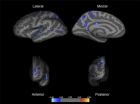INFORMATION:
The three researchers who lead the Bucharest early intervention study – Charles Nelson at Harvard Medical School, Nathan Fox at the University of Maryland and Charles Zeanah at Tulane University – are co-authors on the paper. Other co-authors are Margaret Sheridan and Warren Winter at Harvard Medical School.
The research was funded by the John D. and Catherine T. MacArthur Foundation and the National Institutes of Health.
For more information, contact McLaughlin at mclaughk@uw.edu or 206-616-7863.
Orphanage care linked to thinner brain tissue in regions related to ADHD
2014-10-14
(Press-News.org) Under the rule of dictator Nicolae Ceausescu, thousands of Romanian children were placed in overcrowded orphanages with bleak conditions and minimal human contact. Even after the 1989 revolution, the legacy of institutionalization continued. Only recently has research and public concern over early childhood environments caused changes in policies.
University of Washington research on children who began life in these institutions shows that early childhood neglect is associated with changes in brain structure. A paper published this month in Biological Psychiatry shows that children who spent their early years in these institutions have thinner brain tissue in cortical areas that correspond to impulse control and attention.
"These differences suggest a way that the early care environment has dramatic and lasting effects for children's functioning," said lead author Katie McLaughlin, a UW assistant professor of psychology.
Since 2000, the Bucharest Early Intervention Project has worked to document and treat the children's health. McLaughlin joined the team about six years ago to focus on brain development.
This study is among the first in any setting to document how social deprivation in early life affects the thickness of the cortex, the thin folded layer of gray matter that forms the outer layer of the brain.
"We find a pervasive pattern of differences [among institutionalized children] in areas of the brain related to attention, working memory and social cognition," McLaughlin said.
It's known that children raised in institutions tend to have attention deficit hyperactivity disorder, or ADHD, about four or five times more often than other children, McLaughlin said. The new work suggests how this happens.
The study provides "very strong support" for a link between the early environment and ADHD, McLaughlin said.
Researchers compared brain scans from 58 children who spent at least some time in institutions and 22 non-institutionalized children from nearby communities, all between the ages of 8 and 10. This was the first time in the ongoing study that the children underwent an MRI scan, which creates a 3-D map of the brain.
Related research last year found children raised in the orphanages had less gray matter overall, while this study pinpoints the location of those differences. The most significant changes were in areas of the brain related to working memory and attention.
The brain scan images can explain more than 75 percent of the difference in symptoms of ADHD between kids who did and did not spend time in institutions. Thinning was seen in children who left the institution as early as 8 months of age. Researchers also found that the thinner the brain tissue, the more symptoms of inattention and impulsivity the children displayed.
Researchers did not find differences in the volume of sub-cortical structures. No significant difference was seen between girls and boys, who were about equally represented.
When the study began in 2000, some of the young children remained in institutions, while others were adopted by foster families selected and trained by the research team to try to reverse the effects of early neglect. Of the 58 children in the study who spent time in an institution, the new study finds little differences in brain structure between the 31 who remained for a longer time and the 27 who went into high-quality foster care before their third birthday.
"It's surprising, and a little disappointing," McLaughlin said. Most characteristics measured by the study were dramatically improved among the children moved to foster care.
"It's one of the few areas [of behavior] where you don't see improvements," McLaughlin said.
The researchers can't pinpoint exactly which conditions acted to alter brain development. Babies in the institutions had their physical needs met but they lacked socialization, language exposure, human touch and emotional attachment with their caregiver. Future research will try to tease out which stimuli are most important for brain development and at what ages.
ADHD has many different causes and can often be treated, McLaughlin said. This study only looked at the link to childhood deprivation.
The results are meaningful for other countries, such as those in Africa, where orphanages and institutions are becoming more common. The findings may also be relevant for less-extreme situations of neglect.
"Paying attention to very early care environments should be an important public health priority, especially for abandoned or orphaned children," McLaughlin said.
She will soon participate in a follow-up study in Bucharest. The children, now teenagers around 16 years old, will participate in physical and mental health checkups and can opt to participate in more detailed tests such as the brain scans.
ELSE PRESS RELEASES FROM THIS DATE:
Corruption of the health care delivery system
2014-10-14
LEBANON, NH – The foundation of evidence-based research has eroded and the trend must be reversed so patients and clinicians can make wise shared decisions about their health, say Dartmouth researchers in the journal Circulation: Cardiovascular Quality and Outcomes.
Drs. Glyn Elwyn and Elliott Fisher of The Dartmouth Institute for Health Policy & Clinical Practice are authors of the report in which they highlight five major problems set against a backdrop of "obvious corruption." There is a dearth of transparent research and a low quality of evidence synthesis. ...
Personalised treatment for stress-related diabetes
2014-10-14
Researchers at Lund University in Sweden are testing a treatment for type 2 diabetes which targets the disease mechanism itself - and not just the symptoms. For the first time, knowledge about the individual patient's genetic risk profile is being used. The treatment completely restores the capacity to secrete insulin, which is impaired by the risk gene.
"The concept of treatment personalised to the individual's risk profile has great potential. Our results show that it is possible to block the effects of a common risk gene for type 2 diabetes", says Anders Rosengren, ...
Are there enough fish to go around?
2014-10-14
Scientists from the University of York have released a report highlighting the gap between declining wild fish supplies and healthy eating advice recommending more seafood.
While the health benefits of eating fish have become better appreciated in recent years, many wild fish stocks continue to be overfished.
In a study published in Marine Pollution Bulletin, Dr Ruth Thurstan, now a Research Fellow at the University of Queensland, and Professor Callum Roberts, Professor of Marine Conservation at the University of York, used historical fisheries data and population ...
Immune cells in the liver drive fatty liver disease and liver cancer
2014-10-14
The results of their research have been published as the cover story of the renowned medical journal Cancer Cell.
Fatty liver disease – alongside fatty liver due to massive alcohol consumption – is mainly caused by excessive consumption of fat and sugar combined with a lack of exercise or a sedentary life style. This is referred to as non-alcoholic fatty liver disease (NAFLD). If NAFLD becomes chronic – e.g. through the constant uptake of high lipids and high sugar combined with lack of excercise a chronic inflammatory response is triggered in the liver ...
Parkinson: How toxic proteins stress nerve cells
2014-10-14
This news release is available in German. FRANKFURT Parkinson's Disease is the second most common neurodegenerative disorder. In Germany alone, almost half a million people are affected. The focus of the disease is the progressive degeneration of dopamine-producing nerve cells in a certain region of the midbrain, the substantia nigra. Misfolded proteins are the cause. Until recently, it was unclear why damage is confined to specific nerve cells. A team or researchers led by Frankfurt neurophysiologists has now defined how this selective disease process begins using ...
Researchers identify potential drug that could help treat cystic fibrosis
2014-10-14
From an early age, the lungs of individuals with cystic fibrosis (CF) are colonised and infected by bacteria, a common example being S. aureus. These bacterial infections cause the lungs to become inflamed, infected, and can eventually lead to permanent lung damage. Researchers from the University of Pennsylvania and the Howard Hughes Medical Institute previously showed that an enzyme called Sphingomyelin phosphodiesterase C (SMaseC) produced by the S. aureus bacterium may harm the health of CF patients. Now, they have discovered an inhibitor for this pathogenic bacterial ...
More physical activity improved school performance
2014-10-14
Just two hours of extra physical activity each week can improve school performance. This has been shown by a study of approximately 2,000 twelve-year-olds carried out by scientists at the Sahlgrenska Academy, University of Gothenburg.
The scientists Lina Bunketorp Käll, Michael Nilsson and Thomas Linden, at the Centre for Brain Repair and Rehabilitation at the Sahlgrenska Academy, University of Gothenburg, have tested the hypothesis that increased physical activity stimulates learning and improves school performance.
In the study, published in the scientific periodical ...
The neuroscience of holding it
2014-10-14
Wherever you are right now: squeeze your glutes. Feel that? You just also contracted your pelvic floor too, whether you wanted to or not.
Scientists studying the source of chronic abdominal and pelvic floor pain found an unexpected connection in the brain between the pelvic floor – the muscle responsible for, among other things, keeping you from peeing your pants – and various muscles throughout the body. They've found some evidence for a link as far away as the toes (try tapping a toe and see if you feel the clench), but the strongest link so far is with ...
Rediscovering Venus to find faraway earths
2014-10-14
WASHINGTON, Oct. 14, 2014—Astronomers Chih-Hao Li and David Phillips of the Harvard-Smithsonian Center for Astrophysics want to rediscover Venus—that familiar, nearby planet stargazers can see with the naked eye much of the year.
Granted, humans first discovered Venus in ancient times. But Li and Phillips have something distinctly modern in mind. They plan to find the second planet again using a powerful new optical device installed on the Italian National Telescope that will measure Venus' precise gravitational pull on the sun. If they succeed, their first-of-its-kind ...
US college students eat their vegetables. Really?!
2014-10-14
U.S. college students do better than their counterparts in the United Kingdom when it comes to physical activity, a healthy diet and less smoking, according to new research published in the latest issue of the journal Education and Health.
"Among U.S. students, we see greater consumption of fruits and vegetables, more participation in organized sports, and less smoking," said American University Prof. Stacey Snelling, a lead study author. "Participation in organized sports and exercise could reflect the more formal focus on physical activity at the college level that ...



